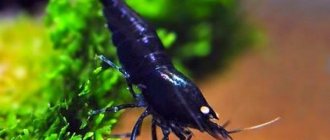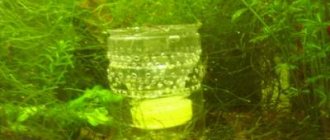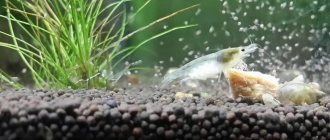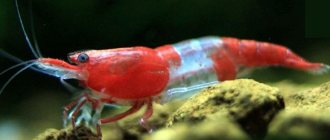Imposing, leisurely fish in an aquarium are beautiful and interesting. But other aquarium inhabitants – shrimps – are no less entertaining. Neocaridins are perfectly adapted for living at home. And the ease of keeping and a large selection of colors make this aquatic pet a wonderful object of observation.
- Size: 2.5-3.5 cm
- Temperature: +18-28⁰С
- Content difficulty: easy
- Behavior: peaceful
- Habitat layer: lower
- gregariousness: gregarious
- Water pH: 6.5-7.5
- Water type: fresh
Content Features
A properly equipped shrimp container relieves the owner of some of the major hassle.
And knowing the basic rules of care will help prolong the life of these creatures and protect them from diseases.
Shrimp
For the first shrimp tank, a rectangular or square container with a volume of 30 liters or more is suitable.
Be sure to provide the jar with a lid; many subspecies of neocaridina can crawl out of the container. Lighting will only be required if aquatic plants are planted in the container.
A small shrimp does not need a filtration system. A compressor will cope with this task perfectly, but keep in mind that it should not create strong currents in the water. And be sure to cover the compressor outlet with a sponge or fine mesh - otherwise the device will “suck in” small creatures or draw in their offspring.
When choosing a jar, keep in mind that the larger its volume, the less effort you will have to expend on maintaining bio-equilibrium.
A thermostat will not be superfluous in the cool season. but in hot weather, a fan may be needed to reduce the water temperature. Although many shrimp farmers simply lower a bottle of frozen water into a container to adjust the water temperature.
Water parameters
For neocaridina, the aquatic environment must be absolutely clean and well saturated with oxygen. Therefore, you need a good aerator, which is especially necessary during warming (in conditions from +27⁰C, neocaridins acutely feel the lack of oxygen). Water parameters cannot be considered strict; neutrality remains the main rule:
- acidity 6.5-7.5 pH;
- medium softness: kH 3-4⁰ and gH 6-8⁰.
Neocaridins are very susceptible to chloride and ammonia substances, nitrates and nitrites. The presence of heavy metals, especially copper, in the aquatic environment is unacceptable for them. Every 5-7 days it is necessary to change the water in the volume of 1/5 part. And, of course, regularly siphon the bottom, clearing the soil of waste and food debris.
It is strictly forbidden to use any aerosol sprays – deodorants, fresheners, etc. – near shrimp.
Priming
For neocaridines, it is better to take a soil that is neutral in chemical composition, for example, quartz.
If funds allow, purchase specially created soil for shrimp - it helps maintain a stable ecosystem.
Based on the color scheme, choose dark-colored soil to highlight the brightness of your pets.
Considering that shrimp like to dig into the soil, lay it in a layer of at least 4-5 cm.
Aquatic plants and decorations
For small Neocaridins, accessories and aquarium plants are necessary - they provide a refuge for shy aquatic creatures. For shrimp, it is better to choose unpretentious plants:
Mosses (liver or Javanese)
Kabomba
Naiad
Cladophora
Riccia
Indian fern
Caring for neocaridines when shedding
Neocaridins molt during development and growth. They renew the hard shell, which does not have the ability to grow.
During the period of growing a new protective cover, these creatures become extremely vulnerable.
Therefore, the number of shelters should be increased to prevent the creation of stress factors.
Various hollow ceramic pipes and large sinks can act as shelters.
The frequency of molting depends on the age of the shrimp:
- young animals molt every 5-6 days;
- adult neocaridins renew their shell 1-2 times a month.
During molting, shrimp need calcium. Therefore, at this time they are given specialized supplements. For example, special tablets for crustaceans or the drug Calcium-Active. You can put a few pieces of regular white chalk on the bottom of the container.
It has been noticed that when the water parameters in the shrimp tank deteriorate, neocaridins begin to molt much more often.
Compatibility of cherry shrimp with fish and shrimp
Cherry shrimp
Cherry shrimp easily become a living target for nearby large aggressive fish. Even small fish like apistogramma can peck and eat them. Therefore, you should choose your neighbors with extreme caution. Small, non-aggressive fish such as rasboras , neons (other small characinkas ), corydoras , otocinclus , dwarf gouramis and some killifish can be good neighbors for cherry shrimp. However, baby shrimp are likely to be eaten by any fish. The abundance of mosses, shelter, grass and ants eliminates this problem.
How to feed shrimp
Under natural conditions, neocaridine shrimp feed mainly on carrion. Domestic shrimp are more omnivorous. The diet for them can be compiled as follows:
- small pieces of vegetables (cabbage, zucchini, spinach, cucumbers) and herbs scalded with boiling water;
- bread crumbs, fish pieces, squid, earthworms, bloodworms;
- ready-made feeds (fish food in the form of flakes and granules is suitable);
- special feed created for shrimp.
2-3 hours after feeding, all remaining food must be removed from the container. They quickly dirty the water. And insatiable creatures can overeat, which will have a bad effect on their condition.
Shrimp need to have fasting days. During this period, it is better to clean the shrimp tank from dead organic matter (detritus).
Appearance and gender differences
Red cherry shrimp has many color forms - brown, orange, red, blue, there are dark blue and even black specimens. In addition, representatives of this species can quickly change color. The use of feed rich in astaxanthin helps to significantly enhance the color intensity. Young females, 10 mm long, are distinguished from males by a slowly developing neck spot, which is evidence of the formation of ovaries. A significant increase in this “saddle” means the imminent appearance of offspring. Large females of red shrimp reach 45 mm in length, males are generally smaller - no more than 20 mm.
Breeding rules
The unique features of aquarium neocaridines include their ability to reproduce rapidly. In just 3-4 months, shrimp can triple their population. For successful shrimp reproduction, only three conditions are necessary:
- The presence of creatures of different sexes in a flock.
- Stability in the parameters of the aquatic environment.
- A good and regular source of food.
In adult neocaridine females, one can distinguish a bright, yellow formation on the back - the saddle. These are eggs that gradually move to the legs under the tail (pleopods).
Female shrimp are larger in size and much brighter. Males can be distinguished by a calmer color scheme and a thin tail. Mating games among shrimps take place according to a certain scenario:
- The female calls the male by releasing odorous pheromones into the aquatic environment.
- Males, attracted by the aroma, begin to rapidly rush around the container, looking for a mate.
- The fertilization process takes 2-3 seconds.
But the female will bear the eggs for about a month. At this time, you can see how the color of the caviar changes from whitish to green. Before hatching, the fry may even have tiny eyes.
If the shrimp are adjacent to other inhabitants in the aquarium, it is better to place the female in another container immediately before the eggs hatch.
Population control
The emerging young look like transparent and exact copies of their parents.
The fry develop quickly and after 9-10 months they also begin to look for a partner to mate with. By the way, shrimp independently regulate the size of their population. If there are too many of them, adult males begin to drive the young away from their territory and do not allow them to mate.
Therefore, if the plan is to obtain a large number of offspring, then it is better to place young neocaridins in other containers, where they will form their families.
Illegal crossbreeding
Bright representatives of the neocaridine species are the result of the work of breeders. Many novice shrimp keepers are confident that if the aquarium is stocked with shrimp of different colors, it will be able to obtain a new, uniquely beautiful species. But the peculiarity of aquarium neocaridines is the fact that when crossed they do not inherit the best parental traits.
If you cross two species of shrimp that are different in color, the offspring will be gray, faded and inconspicuous.
Habitat
Red fire shrimp mainly distributed in Korea, Taiwan, Japan, South China, and were introduced to Hawaii. These regions are sometimes classified as the tropics, although climatically they are subtropical zones. Red Cherry Shrimp are found in shallow streams, lakes and rivers. The biotopes are very diverse: from reservoirs with gravel soil and without vegetation to densely overgrown peat ponds. The development of new habitats is very successful, even to the point that in places where Red fire shrimp appear, other species of shrimp begin to disappear over time (by the way, this happens even in aquariums).
Due to its elegant glowing red color and incredibly easy reproduction, this type of shrimp has the same popularity as Crystal Red and today it is one of the most common types of dwarf shrimp. Red fire shrimp were recently imported from Taiwan, and their appearance was a real shrimp boom.
Neocaridin species
When choosing neocaridine for an aquarium, shrimp keepers focus on the brightness and unusual color color. The gradation of their types occurs according to this principle.
Riley family
One of the extensive variations of the neocaridine family. Rileys were created by Taiwanese breeders in 2010. All subspecies of these shrimp are distinguished by clear and colorful lines:
- Red Rili (Red-Rili) is recommended for beginner shrimp fishermen, it has a transparent belly, yellow caviar
- Red-Rili-Blu has a bright red tail and head, the middle part of the abdomen is pale blue, and the eggs are yellowish.
- Black-blue Rili (Blue-Carbon-Rili) has a rich black tail and head with a bluish tint, the rest of the abdomen is transparent turquoise with blue-black dots, the eggs are yellow
Other varieties:
- Bloody Mary (Bloody-Mary) is distinguished by its bright, rich scarlet color, one of the most impressively beautiful neocarids
- Painted-Fire-Red, before Bloody Mary, was considered the brightest in color, it also has a red, well-painted color, but is not as colorful as Mary
- Kanoko has a dark burgundy color, with small black spots running down its body, the color of the caviar is also black
- Yellow (Yellow) has a pleasant yellowish color / bright yellow caviar
- Yellow Sakura (Yellow-Sakura) is valued higher than ordinary Yellow, the color is more saturated, golden
- Green Jade (Green-Jade) color varies from greenish-brown to deep green, eggs are dark green in color, there is a stripe running along the back, very unusual and beautiful for a home aquarium
- Blue Dream (Blue-Dream) has a bright blue color with a blackish deep tint, Blue Dream has its own variation - Blue Velvet, distinguished by a soft bluish color
- Blue Diamond - a bright, deep turquoise hue of the body as if illuminated from within, with a blue stripe running down the back
- Chocolate (Schoko) color is light chocolate, along the entire body there are lines resembling cracks from brown to black
- Black Rose (Black-Rose) is completely black, a rather stylish and unusual individual that reproduces quickly and is unpretentious
Many colored neocaridine species can change their color depending on the incident light. For example, black ones take on a scarlet tint, and blue ones become purple.
Color gradations
You can read in detail about all the available gradations of red cherry shrimp in the article on classification.
Sakura Red Shrimp
The female's body is almost entirely red, there may be some translucent areas near the underbelly, and the saddle may be visible. Clefts in the shell may be visible.
Males are similar to male cherry shrimp and can be almost colorless.
Fire Red Shrimp
The body and legs are red, without the formation of clefts on the shell. There may be some minor lightening on the legs, but overall they should be red. Some translucency of the carapace is still possible, so that the saddle is still visible, but in poor light it is difficult to see.
Taiwan Fire Red Shrimp
Very similar to fire shrimp, except for two notable features. Firstly, Taiwanese shrimp have a clear uniformity of color, with red covering all visible parts of the shrimp. Secondly, they have a higher percentage of offspring with similar characteristics than regular fiery reds, approximately 80-90% similar.
This morph has a deeper dark color in both males and females. The saddle is rarely visible, even under direct light, and the males look approximately like a high-grade red cherry tree, and may even be colored like the female.











